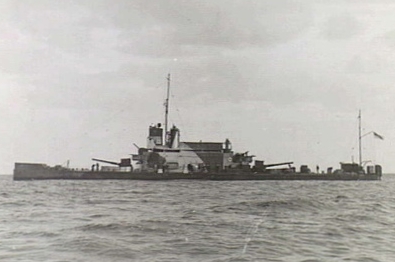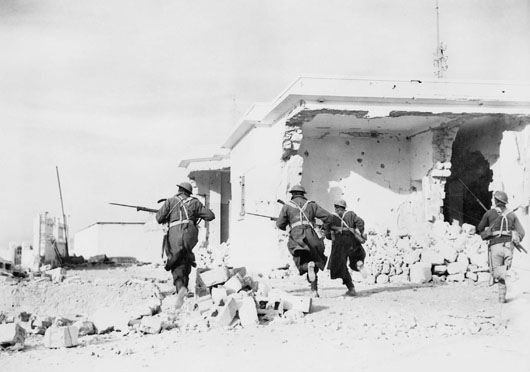| Western Desert Force:
The Initial Campaign, Part Three
By David Lippman
March 2016
In Part Two, the British Empire's forces struck back against the Italians, overwhelming the Italian invaders of Egypt.
As Gen. Sir Richard O’Connor sketched his next moves, he received a telegram from Wavell ordering the detachment of 4th Indian to the Sudan. 6th Australian Division would replace it, but not right away. That would leave O’Connor with only 16th British Brigade, 7th Armoured, (whose tanks needed repair) and Selby Force with its French Marines. Not enough to guard PoWs, collect abandoned vehicles, or provide water for all.
The logical move was to halt the advance, and Wavell was advising just that. Instead, O’Connor, an admirer of Stonewall Jackson and Ulysses S. Grant, decided to maintain the pace of the offensive.
On the night of the 11th, Graziani finally took action. He pulled the Italian 62nd and 63rd Divisions under a sandstorm. “Recognizing the impossibility of damming the enemy march on the desert flats, I thought it essential to put to full use the unique natural obstacle at Halfaya, while throwing strong reinforcements into Bardia and Tobruk,” he signalled Mussolini. To defend the pass, the only gap in the long escarpment, Graziani threw in an armored brigade and Bergonzoli, a Spanish Civil War veteran whose huge beard was reputed to give off sparks, hence the nickname “Electric Whiskers.”
In Rome, Mussolini faced the loss of four divisions, two of them Blackshirts, with remarkable cool. Mussolini “maintains that the many painful days through which we are living must be inevitable in the change fortunes of every war,” Ciano wrote.
While Graziani cut orders from his 60-foot-deep Cyrene bunker, O’Connor did the same from his staff car in the desert. Fourth Indian Division was to tidy up the battlefield before withdrawing to the Sudan. If the Indians could no longer attack, O’Connor wanted them off his ration strength as soon as possible. Sixth Australian was to move up as quickly as it could, and 7th Armoured Division was to keep charging. The 3rd Hussars, in light Mark VI tanks, tried to do so, but beyond Buq Buq they ran into heavy Italian artillery and airpower. O’Connor called for RAF Gloster Gladiators to intercept, but the biplane fighters were out of action after the exertions of the past few days. O’Connor used his superior 25-lbr. guns, and the offensive, despite the loss of a number of tanks, was on again. 7th Armoured Division rumbled forward, heading for Halfaya Pass and Fort Capuzzo, the white brick fort guarding the Libyan border.
The offensive so far was turning into a lark, with 14,000 PoWs in the bag, cheerfully organizing their journey back to Egyptian cages. Despite losses of vehicles to gunfire and maintenance, O’Connor’s force was riding the crest of a wave, boosting morale back in England.
Now O’Connor moved on the tiny Egyptian border port of Sollum (more huts and a pier), which the Royal Navy could use to re-supply him. Then he could push on to Bardia, a larger port. The problem was to move 38,000 PoWs and 4th Indian Division back and bring his supplies and 6th Australian Division up. To solve this, O’Connor used the transport companies of the otherwise unengaged 2nd New Zealand Division.
The pursuit went on. Western Desert Force was renamed 13th Corps. On the 12th, Italian artillery slowed the British. Exhausted troops drove along in the dark under blackout conditions, wearied by noise, repairs, smoke, heat and cold. Next day, O’Connor stripped 7th Armoured’s Support Group of vehicles, so that he had more trucks to keep his tanks topped up with gas.
In his Cyrene bunker, Graziani showed more vigor with his signal pad than with his army. He wired Rome in a panic, to say that Cyrenaica was lost, recommending retreat to Tripoli, claiming the battle was “a flea against an elephant.” Churchill later wrote: “the flea had devoured a large portion of the elephant.”
Mussolini said, “Here is another man with whom I cannot get angry, because I despise him.”
On the 14th, 7th and 4th Armoured Brigades came under heavy Italian air bombardment. SM 79s ranged unmolested, as Wavell had been forced to send some of his aircraft to Greece. Next day, the British offensive resumed.
In Cyrene, Graziani faced the inevitability of losing Sollum and Fort Capuzzo, and pulled the bulk of his force back to Bardia. On the 16th, the British hit Sidi Omar, which was held by 62nd Division, amid minefields and a white stone Beau Geste fort. Lacking infantry, the British bombarded the fort with 25-lbr. guns while the 2nd Royal Tank Regiment’s Matildas charged the place in best cavalry fashion. The lead tank roared into the center of the fort, where the tank commander traded pistol shots with stunned Italians. Before the defenders could overwhelm the Matilda, its squadron mates arrived, and the Italians collapsed.
By the 20th, 7th Armoured, despite exhausted crews and vehicles, had seized Capuzzo and Sollum, but Bergonzoli had been able to muster a considerable defense in Bardia: four divisions of his 21st Corps plus fortress troops, border guards, an anti-tank ditch, concrete blockhouses, and remnants of fleeing units. Altogether Bergonzoli had 45,000 men and 400 guns, and a brigade of M13 tanks. He also had a message from Mussolini, exhorting him to fight to the last.
 Against this O’Connor hurled RAF Wellington bombers, three battleships, and even HMS Aphis, a former Yangtze River gunboat. The little relic of Empire sank several coasters in Bardia harbor. He also cut loose Maj. Gen. Iven Mackay’s 6th Australian Division, the first Diggers to see action in World War II. The division, a mixture of “old sweats” and new volunteers, rode trucks painted with the division’s symbol, a leaping kangaroo, to the battle area. The Australians were eager to find out if Bergonzoli’s beard really gave off sparks. Against this O’Connor hurled RAF Wellington bombers, three battleships, and even HMS Aphis, a former Yangtze River gunboat. The little relic of Empire sank several coasters in Bardia harbor. He also cut loose Maj. Gen. Iven Mackay’s 6th Australian Division, the first Diggers to see action in World War II. The division, a mixture of “old sweats” and new volunteers, rode trucks painted with the division’s symbol, a leaping kangaroo, to the battle area. The Australians were eager to find out if Bergonzoli’s beard really gave off sparks.
The Australians were weighted down with 70 lbs. of kit per man and restricted to a half-gallon of water per day. A man could shave or wash, but not both. “The discomforts the desert imposed were greater than those inflicted by the enemy,” the Australian official history noted.
McKay planned to assault Bardia with 16th and 17th Brigades, estimating that the Italian defenses had only 20,000 men. The valuable armor would prevent the escape of the garrison and move on to Tobruk when Bardia fell. The infantry would drive a wedge through the center of the Italian line, cutting roads, and enabling his men to assault the Italian defenses from behind and annihilate them in detail.
Supplies were still short: 11,500 sleeveless leather jerkins to keep the Diggers warm didn’t arrive until Jan. 1st, and 350 wire cutters didn’t show up until Jan. 2nd, the night before the attack. Three hundred pairs of gloves to protect the hands of men cutting wire were handed out as the infantry moved into their assembly areas, but tape to mark attack routes never arrived. Three-inch mortars did, but without sights. A 17th Brigade officer hopped into a jeep and drove all the way to Cairo and back to pick the sights up.
“Tonight is the night,” wrote 16th Brigade’s official diarist. “By this time tomorrow (5 p.m.), the fate of Bardia should be sealed. Everyone is happy, expectant, eager. Old timers say the spirits is the same as in the last war. Each truckload was singing as we drove to the assembly point. The brigade major and party taped the start-line - historic, for it is the start-line of the Australian soldier in this war.”
At 2:30 the Australian troops, looking enormous in jerkins, greatcoats, and tin hats, lugging 150 rounds of ammo and three days' worth of bully beef, drank a tot of rum and moved forward under a heavy barrage. Engineers led the way with wire cutters and Bangalore torpedoes to remove Italian wire. When the torpedoes went off, the Australians charged through the wire.
The intense artillery bombardment thoroughly frightened the 1st Blackshirt Division, whose only combat experience had been beating helpless civilian “enemies of the state” back in Calabria. Now the Fascist goons found themselves under heavy shelling, and facing enormous Australian infantrymen at point-blank range. So the Italians surrendered. Some thought the Aussies’ leather jerkins were bulletproof.

Giant Australian infantrymen storm into Bardia.
Australian troops marched at ease through the positions, passing Italian troops waving white cloths. Sgt. Ian McIntosh of New South Wales, a World War I veteran, led 24 men to capture three field guns, an anti-tank gun, 12 machine guns, and 104 PoWs. Lt. A.C. Murchison of Newcastle led a bayonet charge that caused the Italians facing him to surrender. As Murchison moved forward, the surrenders took on a chain reaction, and the Aussies were soon thumbing the Italians back, yelling, “Avanti.” The company next to Murchison took 300 PoWs.
“It was now half an hour after midday. By this time an apparently endless column of Italian prisoners was streaming back though the gaps in the perimeter; the officers in ornate uniforms with batmen beside them carrying their suitcases; the men generally dejected and untidy, strangely small beside their captors,” wrote the Australian official history. “When the 2/5th Battalion, marching into the perimeter, saw this column moving toward them, their first thought was that 16th Brigade was being driven back—then came the realisation that the close-packed column, winding like a serpent over the flat country, was a sample of a defeated Italian army.” By noon 6,000 PoWs were in the cage, and McKay had a rude shock when a PoW officer told him the enemy defenses numbered 40,000 men.
Click here to order Western Desert Force and capture Bardia!
David H. Lippman, an award-winning journalist
and graduate of the New School for Social Research,
has written many magazine articles about World
War II. He maintains the World
War II Plus 55 website and currently works
as a public information officer for the city
of Newark, N.J. We're pleased to add his work
to our Daily Content.
|
